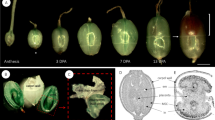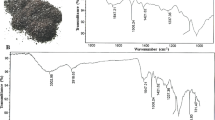Abstract
ANGIOSPERM pollen grains have enzymes which are readily leached out by water. The release begins within minutes of immersion, and is not related to the germination of the grains and the growth of the pollen tube, for it occurs in media which inhibit germination1. If the enzymes were derived from within the pollen protoplast, the rapid leachability would seem to indicate a remarkable permeability of the plasmalemma to proteins. But another possibility is that enzymes and other proteins are situated extracellularly in the pollen grain wall, which has been observed before2. We report here the storage of various hydrolytic enzymes in the pollen walls of ten species of flowering plants, and show that the site of deposition is the cellulosic intine in walls of several different structural types.
This is a preview of subscription content, access via your institution
Access options
Subscribe to this journal
Receive 51 print issues and online access
$199.00 per year
only $3.90 per issue
Buy this article
- Purchase on Springer Link
- Instant access to full article PDF
Prices may be subject to local taxes which are calculated during checkout
Similar content being viewed by others
References
Mäkinen, Y., and Brewbaker, J. L., Physiol. Plant., 20, 477 (1967).
Tsinger, N. V., and Petrovskaya-Baranova, T. P., Dokl. Akad. Nauk. SSSR, 138, 466 (1961).
Knox, R. B., and Evans, L. T., Austral. J. Biol. Sci., 21, 1083 (1968).
Heslop-Harrison, J., J. Ultrastruct. Res. (in the press).
Barka, T., and Anderson, P. J., J. Histochem. Cytochem., 10, 741 (1962).
Seligman, A. M., in Proc. Second Intern. Cong. Histochem. Cytochem., 9 (Springer-Verlag, 1964).
Hanker, J. B., Seaman, A. R., Weiss, L. P., Ueno, H., Bergman, R. A., and Seligman, A. M., Science, 146, 1039 (1964).
Essner, E., and Novikoff, A. B., J. Cell Biol., 15, 289 (1962).
Bitensky, L., Quart. J. Microsc. Sci., 104, 193 (1963).
Enwright, J. B., Frye, F. L., and Atwal, O. S., J. Histochem. Cytochem., 13, 515 (1965).
Pearse, A. G. E., Histochemistry, Theoretical and Applied (J. and A. Churchill, London, 1960).
Shear, M., and Pearse, A. G. E., Exp. Cell Res., 32, 174 (1963).
Heslop-Harrison, J., Symp. Soc. Exp. Biol., No. 17, 315 (1963).
Heslop-Harrison, J., Grana Palynol., 4, 7 (1963).
Erdtman, G., and Dunbar, A., Grana Palynol., 6, 338 (1966).
Larson, D. A., and Lewis, C. W., Amer. J. Bot., 48, 934 (1961).
Stanley, R. G., and Linskens, H. F., Physiol. Plant., 18, 47 (1965).
Author information
Authors and Affiliations
Rights and permissions
About this article
Cite this article
KNOX, R., HESLOP-HARRISON, J. Cytochemical Localization of Enzymes in the Wall of the Pollen Grain. Nature 223, 92–94 (1969). https://doi.org/10.1038/223092a0
Received:
Issue Date:
DOI: https://doi.org/10.1038/223092a0
This article is cited by
-
Cytochemistry of pollen development in Campsis radicans (L.) Seem. (Bignoniaceae)
Plant Systematics and Evolution (2013)
-
Isolation and characterization of a polymorphic stigma-specific class III peroxidase gene from Senecio squalidus L. (Asteraceae)
Plant Molecular Biology (2005)
-
The role of allergenic proteins Pla a 1 and Pla a 2 in the germination of Platanus acerifolia pollen grains
Sexual Plant Reproduction (2005)
-
Endoplasmic reticulum as a storage site for allergenic proteins in pollen grains of several Oleaceae
Protoplasma (1995)
-
Pollen morphology and pollen-wall proteins (localization and enzymatic activity) inSesamothamnus lugardii (Pedaliaceae)
Plant Systematics and Evolution (1992)
Comments
By submitting a comment you agree to abide by our Terms and Community Guidelines. If you find something abusive or that does not comply with our terms or guidelines please flag it as inappropriate.



